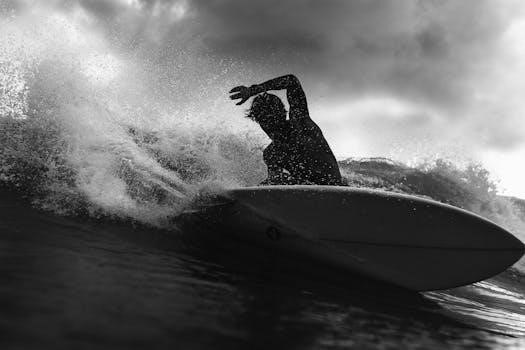Selecting the proper bodyboard length is crucial for performance. A board that is too long hinders control and paddling efficiency. Conversely, a board that is too short lacks sufficient flotation. The ideal length approximates the distance from your chin to your knees, ensuring optimal maneuverability.
Bodyboard sizing is a critical aspect of enjoying and progressing in the sport. Selecting the right size board significantly impacts your control, buoyancy, and overall riding experience. It’s not a one-size-fits-all scenario; various factors come into play, demanding careful consideration. This guide aims to demystify the process, providing you with the knowledge to choose a board that complements your body type and skill level.
The fundamental principle revolves around the board’s length in relation to your body. A general rule of thumb suggests that the board should measure from your chin to your knees. However, this is merely a starting point. Weight distribution, height, and riding style all influence the ideal size.
Understanding these factors is paramount to avoiding common pitfalls. A board that is too large can be unwieldy and difficult to maneuver, while a board that is too small will lack the necessary flotation, hindering your ability to catch waves and maintain speed. By delving into the intricacies of bodyboard sizing, you’ll be well-equipped to make an informed decision and unlock your full potential in the water. Remember, the perfect fit enhances performance and maximizes the fun.
Factors Affecting Bodyboard Size
Several key factors influence the ideal bodyboard size for an individual. Primarily, height and weight play significant roles. Taller riders generally require longer boards to ensure adequate buoyancy and stability. Similarly, heavier riders need larger boards to provide sufficient flotation and prevent the board from sinking.
However, these aren’t the only determinants. Skill level also impacts the appropriate size. Beginners often benefit from slightly larger boards, which offer increased stability and ease of use while learning the fundamentals. As riders progress and develop their skills, they may opt for smaller, more maneuverable boards to execute advanced techniques.
Furthermore, riding style influences board choice. Riders who prefer drop-knee riding, where one knee is placed on the board, typically require longer boards to accommodate their stance and maintain balance. Those who favor prone riding, lying flat on the board, may prefer shorter boards for enhanced control and responsiveness. Ultimately, considering these factors helps in selecting a bodyboard that optimizes performance and enjoyment in the water. Ignoring these aspects can lead to discomfort and hinder progression.
Height and Weight Chart
A height and weight chart serves as a valuable tool for selecting the appropriate bodyboard size. These charts provide a general guideline based on the correlation between a rider’s physical dimensions and the recommended board length. Typically, the chart organizes height ranges in inches or feet and weight ranges in pounds or kilograms, with corresponding suggested board sizes in inches.
For example, a rider who is 5’6″ tall and weighs 140 pounds might find that the chart recommends a 41-inch bodyboard. However, it’s crucial to recognize that these charts offer a starting point and aren’t definitive. Individual preferences, skill level, and riding style should also be considered.
Moreover, some charts may provide overlapping size recommendations, acknowledging that multiple board lengths could be suitable. In such cases, it’s advisable to consider additional factors like personal comfort and desired maneuverability. Consulting multiple charts and cross-referencing information can further refine the selection process. Remember, the goal is to find a board that feels comfortable and allows for optimal performance, so use the chart as a helpful reference rather than a strict rule.
Chin-to-Knee Measurement Rule
The chin-to-knee measurement rule is a fundamental guideline for determining the ideal bodyboard length. This rule suggests that the appropriate board size should roughly correspond to the distance between your chin and your knees. To accurately obtain this measurement, stand upright with your feet shoulder-width apart. Then, use a measuring tape to determine the length from your chin down to the top of your knees.
This measurement provides a personalized estimate of the board length that would offer a balance of buoyancy and control. A board that closely matches this length ensures that you’re not struggling with excessive board size, which can impede maneuverability, nor are you lacking sufficient flotation, which can hinder wave-catching ability.
While this rule is a helpful starting point, remember that it’s not an absolute determinant. Factors like your weight, skill level, and personal preferences can influence the optimal board size. For instance, if you’re heavier than average for your height, you might consider slightly increasing the board length to compensate for the added weight. Similarly, experienced riders might opt for a shorter board for enhanced maneuverability, while beginners might prefer a slightly longer board for increased stability.
Understanding Bodyboard Size Charts
Bodyboard size charts serve as valuable resources for selecting the appropriate board length based on your height and weight. These charts typically present a matrix or table that correlates height ranges with corresponding board sizes, often expressed in inches. To effectively utilize a size chart, accurately measure your height and locate the corresponding range on the chart. The chart will then indicate the recommended board size for your height category.
It’s crucial to recognize that size charts offer general guidance, and individual preferences can influence the final decision. For instance, if you fall between two height ranges, consider your weight and skill level. If you’re closer to the heavier end of the weight range or are a beginner, opting for the larger board size might provide enhanced stability and buoyancy. Conversely, if you’re lighter or more experienced, the smaller size might offer greater maneuverability.
Furthermore, different manufacturers might employ slightly varying size charts. Therefore, consulting multiple charts and comparing recommendations can provide a more comprehensive perspective. Always prioritize charts from reputable bodyboard brands or retailers, as these are more likely to reflect accurate and reliable sizing guidelines. Remember, size charts are a starting point; consider personal factors for optimal board selection.
Weight Considerations for Sizing
Weight plays a significant role in determining the ideal bodyboard size, influencing buoyancy and overall performance in the water. A heavier rider requires a larger board to provide adequate flotation, preventing the board from sinking and ensuring proper planing. Conversely, a lighter rider might find a smaller board more manageable and responsive.
When selecting a bodyboard based on weight, consult size charts that incorporate weight ranges alongside height recommendations. If your weight falls on the higher end of the recommended range for a particular board size, consider opting for the next size up to ensure sufficient buoyancy. This is especially important for beginners who might struggle to maintain balance on a board that lacks adequate flotation.
Conversely, if your weight is on the lower end of the range, a smaller board might offer enhanced control and maneuverability. However, avoid selecting a board that is too small, as it might compromise your ability to catch waves and maintain speed. Ultimately, striking a balance between buoyancy and maneuverability is crucial for optimal performance. Remember to consider your skill level and riding style when making your final decision. Experimentation and personal preference also contribute to finding the perfect fit.
Height Considerations for Sizing
Height is a primary factor in determining the appropriate bodyboard size. Taller riders generally require longer boards to ensure proper distribution of weight and maintain balance. A board that is too short will cause the rider to feel cramped and unstable, hindering their ability to control the board effectively. Conversely, shorter riders may find longer boards difficult to maneuver.
When selecting a bodyboard based on height, a common guideline is to choose a board that reaches from your knees to your chin when held vertically. This measurement provides a general indication of the ideal board length for your body. However, it’s important to note that this is just a starting point, and other factors, such as weight and riding style, should also be considered.
Consult bodyboard size charts that correlate height ranges with recommended board lengths. If you fall between two sizes, consider your weight and skill level. Lighter riders or beginners may prefer the shorter option for easier handling, while heavier or more experienced riders may benefit from the added stability of a slightly longer board. Ultimately, the goal is to find a board that feels comfortable and allows you to perform your desired maneuvers with confidence.

Skill Level and Bodyboard Size
A rider’s skill level significantly influences the ideal bodyboard size. Beginners often benefit from slightly larger boards, providing increased stability and buoyancy, which aids in catching waves and maintaining balance. The added volume makes paddling easier, allowing novices to focus on mastering fundamental skills. These larger boards are more forgiving, minimizing the impact of minor errors in weight distribution and positioning.
As riders progress and develop their skills, they may transition to smaller, more maneuverable boards. These boards offer greater responsiveness, allowing for more advanced techniques such as spins, aerial maneuvers, and carving. Smaller boards require more precise control and a higher level of skill to maintain stability, but they unlock a wider range of performance capabilities.
Advanced riders often experiment with different board sizes to suit specific wave conditions and riding styles. They might opt for a shorter board in smaller, more playful waves to maximize maneuverability, or a longer board in larger, more powerful surf to enhance stability and control. Understanding the trade-offs between board size and performance is crucial for experienced bodyboarders seeking to push their limits. The key is to find a board that complements your current abilities and supports your progression as a rider.
Impact of Riding Style on Board Choice

Riding style significantly dictates the optimal bodyboard size. Drop-knee riders, who ride with one knee on the board and one foot planted, typically prefer longer boards for increased stability and rail line. The added length provides a more secure platform for maintaining balance and executing turns while in this stance. A longer board also helps with wave tracking and control, essential for drop-knee riding.

Conversely, prone riders, who ride lying on their stomach, often favor shorter, more maneuverable boards. These boards allow for quicker turns, spins, and aerial maneuvers. A shorter board is easier to control and allows for greater responsiveness, enabling prone riders to maximize their performance in the waves. The reduced length also makes paddling easier and more efficient.
Ultimately, the choice between a longer or shorter board depends on the individual rider’s preferences and the type of waves they typically ride. Some riders may prefer a versatile board that can handle both drop-knee and prone riding, while others may opt for a specialized board tailored to their specific style. Understanding the nuances of different riding styles is crucial for selecting a bodyboard that complements your technique and enhances your overall riding experience.
How to Measure Yourself for a Bodyboard
Accurately measuring yourself is the first crucial step in selecting the right bodyboard size. The most common and effective method involves measuring the distance from your chin to your knees. Stand upright with your feet shoulder-width apart. Use a measuring tape to determine the length from your chin down to the top of your kneecap. This measurement serves as a primary guideline for your ideal bodyboard length.
Alternatively, you can use the belly button method as a secondary reference. Stand the measuring tape on the floor next to your body. The bodyboard’s length should be within an inch below your belly button.
While these methods provide a good starting point, it’s important to consider other factors such as your weight and skill level. A heavier rider may require a slightly longer board for increased flotation, while a beginner may benefit from a shorter, more manageable board.
When measuring, ensure you are standing on a flat surface and that the measuring tape is held straight. If possible, have someone assist you to ensure accurate measurements. These precise measurements will significantly improve your chances of selecting a bodyboard that provides optimal performance and comfort in the water.
Common Mistakes in Choosing Bodyboard Size
Selecting the wrong bodyboard size can significantly hinder your riding experience. One common mistake is prioritizing board appearance over functionality. Riders often choose boards based on color or design without considering proper fit, leading to discomfort and reduced performance. Another frequent error is relying solely on a friend’s recommendation. Bodyboard size is highly individual, depending on height, weight, and skill level. What works for one person may not work for another.

Ignoring bodyboard size charts is another pitfall. These charts provide a general guideline based on height and weight, helping riders narrow down their options. Overlooking these resources can lead to selecting a board that is either too long or too short. Many beginners often overestimate the size they need, believing a larger board will provide more stability. However, an oversized board can be difficult to control and maneuver, especially in larger waves.
Conversely, some riders choose undersized boards, thinking they will be easier to handle. While a smaller board may offer increased maneuverability, it may lack sufficient flotation, making it challenging to catch waves. Failing to consider personal weight is another common mistake. Heavier riders require larger boards for adequate buoyancy, while lighter riders can opt for smaller sizes. By avoiding these common mistakes and carefully considering your individual needs, you can select a bodyboard that enhances your riding experience.
In conclusion, selecting the right bodyboard size is a multifaceted process that requires careful consideration of various factors. Height and weight serve as fundamental starting points, guiding you towards a general size range. However, these are not the only determinants. Skill level, riding style, and personal preferences also play significant roles in the decision-making process.
Beginners may benefit from slightly larger boards that offer increased stability and ease of catching waves. Experienced riders, on the other hand, might prefer smaller, more maneuverable boards that allow for advanced tricks and tighter turns. Your chosen riding style, whether it be prone or drop-knee, will also influence the ideal board size.
Ultimately, the perfect bodyboard fit is one that feels comfortable and allows you to perform at your best in the water. Don’t be afraid to experiment with different sizes and shapes until you find the board that suits your individual needs. Remember to consult bodyboard size charts, seek advice from experienced riders, and, if possible, test out different boards before making a final decision. By taking the time to find the perfect fit, you’ll maximize your enjoyment and progress in the sport of bodyboarding.
